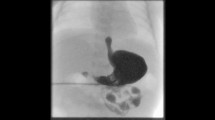Abstract
Introduction
Oesophageal atresia ± tracheoesophageal fistula (EA/TEF) associated with congenital heart disease (CHD) carries a worse prognosis than EA/TEF alone. Though the Spitz classification takes major CHD into account, there are no data regarding survival with the specific combination of EA/TEF and Tetralogy of Fallot (TOF). With advances in postnatal care, we hypothesised that, survival is improving in these complex patients. This study reports morbidity and mortality outcomes of newborns with oesophageal atresia and TOF cardiac malformations
Methods
All patients with EA/TEF and TOF treated at Alder Hey Children’s Hospital between the years 2000–2020, were identified. Data sets regarding gestation, birth weight, associated anomalies, operative intervention, morbidity, and mortality were analysed.
Results
Of a total of 350, EA/TEF patients 9 (2.6%) cases had EA/TEF associated with TOF (M:F 4:5). The median gestational age was 35/40 (range 28–41 weeks) with a median birth weight of 1790 g (range 1060–3350 g). Overall survival was 56% (5/9 cases) and all survivors remain under follow up (range 37–4458 days). Surgical strategies for managing EA/TEF with Fallot’s tetralogy included 6/9 primary repairs and 3/9 cases with TEF ligation only (+ gastrostomy ± oesophagostomy).
Conclusions
This study reports outcome data from one of the largest series of EA TEF patients with Fallot’s tetralogy. Whilst outcomes may be challenging for this unique patient cohort, survival metrics provide important prognostic information that can be widely shared with health care teams and parents.


Similar content being viewed by others
References
Leonard H et al (2001) The influence of congenital heart disease on survival of infants with oesophageal atresia. Arch Dis Child Fetal Neonatal Ed 85(3):F204–F206
Spitz L et al (1990s) Oesophageal atresia: at-risk groups for the 1990s. J Pediatr Surg 29(6):723–725
Spitz L (2007) Oesophageal atresia. Orphanet J Rare Dis 2:24
Tennant PW et al (2010) 20-year survival of children born with congenital anomalies: a population-based study. Lancet 375(9715):649–656
Gross RE (1953) The surgery of infancy and childhood. Its principles and techniques. W.D Saunders Co, Philadelphia
Sulkowski JP et al (2014) Morbidity and mortality in patients with esophageal atresia. Surgery 156(2):483–491
Stoll C et al (2017) Associated anomalies in cases with esophageal atresia. Am J Med Genet Part A 173(8):2139–2157
David TJ, O'Callaghan SE (1974) Cardiovascular malformations and oesophageal atresia. Br Heart J 36(6):559–565
Webber EM, Gillis DA, Ross DB (1996) Tetralogy of Fallot with total anomalous pulmonary venous drainage and esophageal atresia: complete correction in infancy. Ann Thorac Surg 62(2):571–573
Puri K et al (2018) Characteristics and outcomes of children with ductal-dependent congenital heart disease and esophageal atresia/tracheoesophageal fistula: a multi-institutional analysis. Surgery 163(4):847–853
Diaz LK et al (2005) Tracheoesophageal fistula and associated congenital heart disease: implications for anesthetic management and survival. Paediatr Anaesth 15(10):862–869
Waterston DJ, Carter RB, Aberdeen E (1962) Oesophageal atresia: tracheo-oesophageal fistula: a study of survival in 218 infants. Lancet 1(7234):819–822
Poenaru D et al (1993) A new prognostic classification for esophageal atresia. Surgery 113(4):426–432
Funding
This study has received no funding.
Author information
Authors and Affiliations
Corresponding author
Ethics declarations
Conflict of interest
Kathryn O’Shea declares that she has no conflict of interest. Megan Griffith declares that she has no conflict of interest. Alan King Lun Liu declares that he has no conflict of interest. Paul Losty declares that he has no conflict of interest. Matthew Jones declares that he has no conflict of interest. Joanne Minford declares that she has no conflict of interest. Fiona Murphy declares that he has no conflict of interest.
Ethical approval
This article does not contain any studies with human participants or animals performed by any of the authors.
Additional information
Publisher's Note
Springer Nature remains neutral with regard to jurisdictional claims in published maps and institutional affiliations.
Rights and permissions
About this article
Cite this article
O’Shea, K.M., Griffiths, M.L., King, K.L. et al. Esophageal atresia and tracheoesophageal fistula associated with tetralogy of Fallot: a review of mortality. Pediatr Surg Int 36, 1243–1247 (2020). https://doi.org/10.1007/s00383-020-04732-x
Accepted:
Published:
Issue Date:
DOI: https://doi.org/10.1007/s00383-020-04732-x




